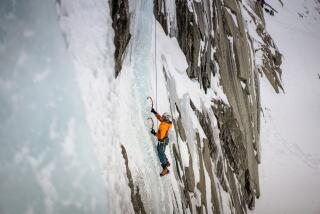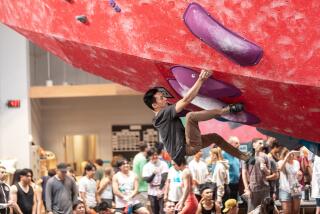Rock Climbing: Fun, But Not for Fitness
WASHINGTON — Trying to increase your fitness by rock climbing would be an uphill battle.
Even on specialized indoor equipment that allows long climbs, climbing is not as effective as treadmill running, according to a new study. Climbers instead do more of a sprint--short power bursts followed by rest.
“If they sustain the climb for long enough, they are able to sustain an aerobic training effect, but sustaining that energy output might be difficult,” said Phillip B. Watts, a professor of exercise physiology at Northern Michigan University, Marquette.
Watts examined two measures of aerobic output--how fast the heart beats and how much oxygen the exerciser uses. In the experiment, 16 experienced climbers with an average age of 26 worked out on an indoor climbing wall that functioned rather like a treadmill, continuously moving as the subject climbed.
Climbers did five four-minute climbs interspersed with six-minute rests. They climbed at wall angles ranging from nearly vertical to slightly overhanging. For comparison, the exercisers did treadmill runs over the same time periods at a heart rate equal to what they did when the wall was nearly vertical.
The results were published in the American College of Sports Medicine journal Medicine and Science in Sports and Exercise.
Ay the same heart rate, oxygen use was greater for running than for climbing, the study found. So climbers who judge their aerobic energy use by their heart rate may be misled, Watts said. If they want to climb as hard as they run, they would have to raise their target heart rate by five to 10 beats per minute, he said.
Climbers tended to go more slowly when the angle got sharper, which took some of the edge off the exercise, the report said. The result was that the climbers held their oxygen use stable across the different angles.
Nonetheless, the climbers said they felt they were exercising harder on the tougher inclines. This may be due, in part, to the greater demands for finger strength on the grips on the steeper slopes, Watts said.
Handgrip strength weakened on the rougher angles, and blood lactate--a measure of the accumulated chemical wastes of exercise--was higher when the climber was gripping an overhang.
The idea that rock climbing doesn’t require a lot of endurance did not surprise Dave Pegg, a climber and senior associate editor of Climbing magazine, in Carbondale, Colo. “Rock climbing is very stop-starty,” he said. “You spend a lot of time sitting on a belay.”
Pegg said he doesn’t get the same out-of-breath feeling from rock climbing that he does from running.
However, rock climbers look fit. They carry little body fat. A separate study, focusing on elite climbers, found the competitors “very lightweight, small people,” Watts said. Men had only 5% body fat, and women averaged 8% or 9%--”very low for females,” Watts said.
The leanness of climbers may confuse people, said Dale Goddard of Salt Lake City, a coauthor of “Performance Rock Climbing,” considered one of the basic texts of the sport.
The climbers’ leanness is not necessarily from endurance, but simply because the sport favors the thin and muscular, Goddard said. Anything that is not muscle or bone is waste weight that has to be carried up the climbing wall, so heavier people tend not to make the grade, he said.
“Most people, when they are climbing, feel it is strength-oriented because it is very demanding of upper-body strength,” Goddard said. “We are not used to supporting our weight on our arms and fingers.”






